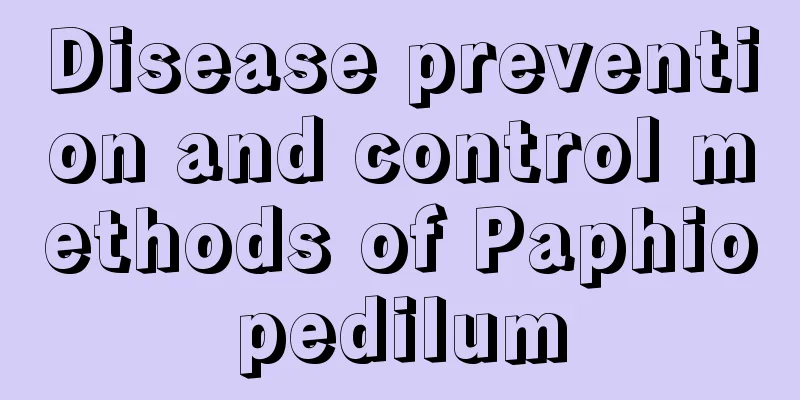Disease prevention and control methods of Paphiopedilum

Damping-offSymptomsIt often occurs when the seedlings are out of the bottle. After the plants are damaged, they gradually rot in the roots and stems of the seedlings. The affected part gradually sinks and becomes dark brown. When it is moist, white mycelium gradually grows out of the diseased part. When the situation is serious, a large number of seedlings will die. Prevention and treatment methodsReducing the planting density can ensure ventilation in the orchid garden. Remove diseased plants promptly, and do not allow water to accumulate in the substrate for a long time. The disease is more serious when the temperature is high and the humidity is high, and it often occurs during the growth period of medium and large seedlings. When preventing and controlling the disease, ventilation should be increased and air humidity should be reduced. Spray the powder once every ten days or so, and spray 2-3 times in succession. Brown spotSymptomsThe disease is easily caused by high temperature and high humidity environment and when water accumulates on the leaves. The infected leaves will initially appear as small dark green spots, which will gradually expand to form water-soaked spots under suitable conditions. In severe cases, the leaves will change color. Prevention and treatment methodsDuring prevention and control, ventilation should be increased and air humidity should be reduced. In the early stage of the disease, you can use orchid disease prevention and control drugs such as orchid disease prevention drugs, and use them alternately. At the same time, cut off the diseased parts of the diseased leaves and apply antibiotics. anthraxSymptomsIt mainly harms the leaves of Paphiopedilum. In the early stage of the disease, the lesions will appear as small brown spots, and in the later stage, round or irregular lesions will form. The lesions are concave and easy to break. High temperatures, high humidity and poor ventilation can all cause anthrax. Prevention and treatment methodsWhen the disease occurs, the diseased leaves must be cut off in time and sprayed with pesticides. In seasons with high temperatures and high humidity, the number of spraying needs to be increased, about once every 5-7 days, and 3 consecutive sprayings are sufficient. Black rotSymptomsBlack rot, also known as blight, is the most serious orchid disease. It mostly occurs on new young leaves and their leaves. After 2-3 days, it will begin to spread downward and turn into dark brown rot. When the temperature is high and the humidity is high, it will infect the leaf surface and appear as large water-soaked spots. Prevention and treatment methodsKeep the greenhouse well ventilated and take preventive measures. WiltSymptomsAfter infection, the plants become dwarfed, shrunken and yellow. The leaves of the healthy plant drooped, the leaf tips turned yellow, and the whole plant looked weak and lifeless. Prevention and treatment methodsPrevention should be the main focus when it comes to prevention and treatment. Before the disease occurs, you need to spray the orchid disease-preventing agent once every 7-10 days, and spray 3-4 times in a row. If serious diseased plants appear, they must be cleared out of the greenhouse in time and the cultivation beds must be disinfected with fungicides. Root rotSymptomsAfter the plants are infected, they become dwarfed and cannot bloom normally. Most of their roots and leaves rot, and they wither and die. The disease is caused by the spread of bacteria in the substrate or excessive use of chemical fertilizers. Prevention and treatment methodsDisinfect the substrate before planting, and replace the diseased soil with disease-free soil. Avoid excessive nitrogen fertilizer during the growing period. When individual diseased plants are found, they should be removed outdoors in time and sprayed with pesticides immediately. Spraying should be carried out every 1-2 weeks, and it takes about 3-4 consecutive times. Sclerotium rolfsiiSymptomsIt often occurs at the roots, base of stems and leaves, causing rot of the roots and stems and softening of the leaves. The greenhouse should always be well ventilated and the spacing between potted flowers should not be too close. Prevention and treatment methodsWhen the disease occurs, you can apply orchid disease control for spraying once a week, and 3-5 times in a row is best. Contaminated potted flowers should be removed from the room and destroyed promptly. |
<<: Prevention and control of leaf spot disease of Paeonia suffruticosa
>>: Black rot control of Cymbidium
Recommend
How long is the growth cycle of Lingzhi?
Introduction to Ganoderma Lucidum Growth Ganoderm...
Hydroponic method of lucky bamboo
Hydroponic method of lucky bamboo Pruning roots a...
What is the function of tiger lily
Medicinal value of Tiger Lily Lilium has high med...
What to do if lily of the valley has root rot
1. Reasons 1. Too much water This is the main rea...
How long is the growth cycle of a willow tree?
Willow growth cycle The growth cycle of willow tr...
The efficacy and function of mint, how to eat mint leaves
1. Efficacy and Function 1. Strengthen the stomac...
Desert Rose prefers shade or sun
Desert Rose prefers shade or sun Desert rose is r...
How to breed Wucai Su and what to pay attention to
Reproduction method of five-color su There are tw...
The flowers in her house bloomed one after another, and nothing could be stopped!
Jasmine The jasmine flowers in some flower lovers...
How to water red spider grass
Watering tips for red spider lily Red spider gras...
Is it good to water flowers with sugar water? The benefits of using sugar water to water plants and flowers
Is it okay to water flowers with sugar water? It ...
What kind of soil should be used to plant daffodils (methods and precautions for growing daffodils in soil)
Daffodil planting soil Many flower lovers have se...
What are the cultivation methods and precautions of Selaginella
Selaginella cultivation method When caring for Se...
The language and legend of Gesang flower
The flower language of Gesang flower The flower l...
What can't be eaten with durian?
Durian is a typical tropical fruit, which stands ...









